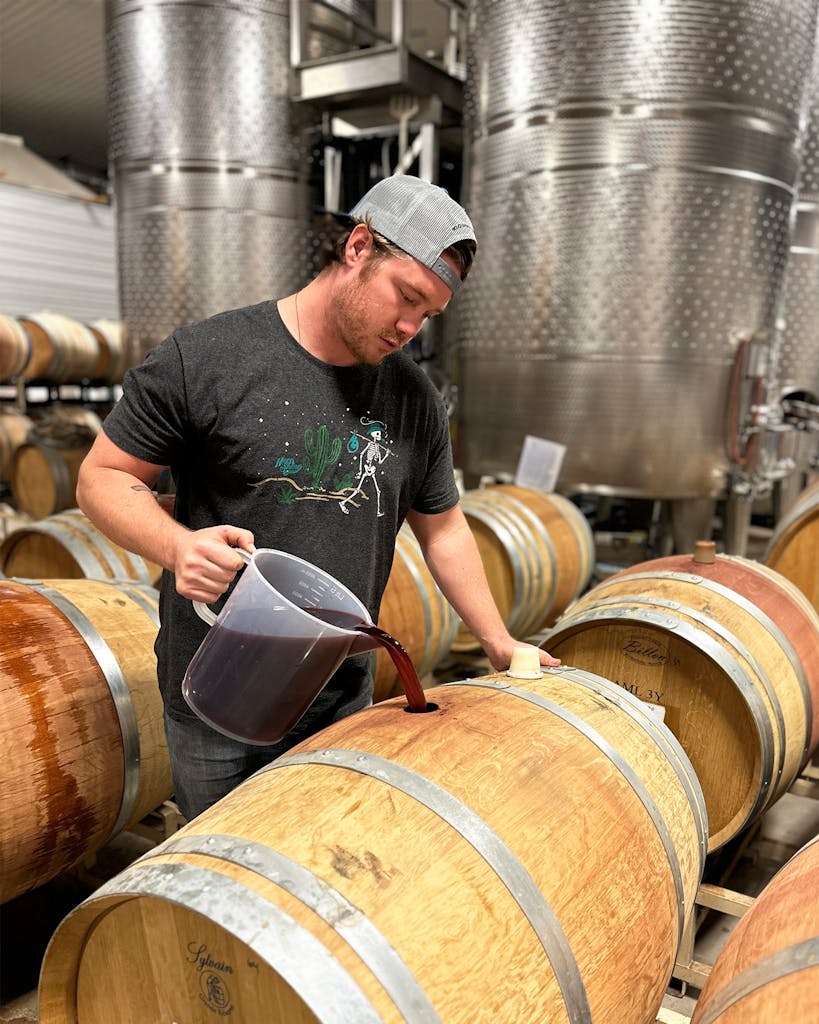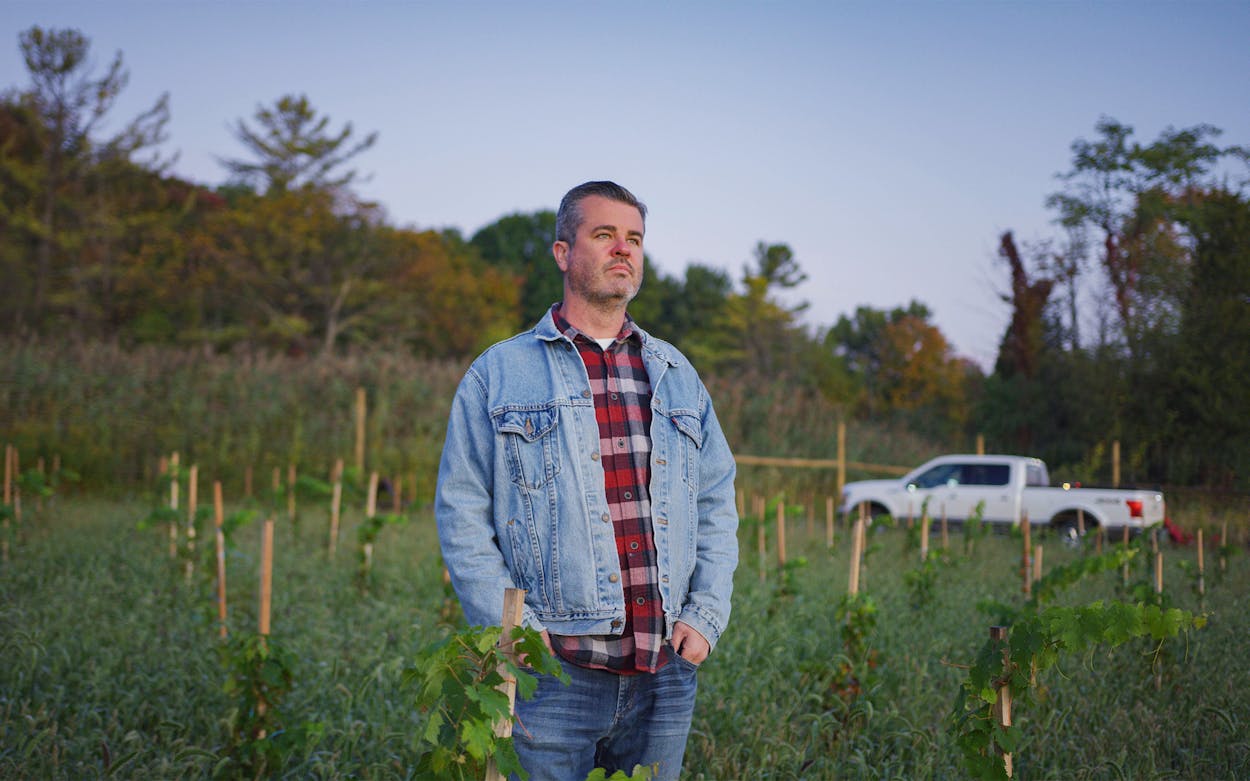As spring kicks into high gear, Texas wine lovers hit the road once again to explore the plentiful wineries that dot the Hill Country to enjoy a glass of tempranillo alongside swaths of wildflowers.
Regulars will notice a few new vintners in the area. But what might not be obvious from a quick glance while driving is that these businesses hightailed it from other states to be a part of Texas’s growing wine scene.
In 2022, WineAmerica conducted an economic impact study—taking sales, tourist expenditures, and taxes into consideration—to determine how wine affects every state in the country. It found that the economic impact of the wine industry in Texas was $20.3 billion, which represents a 55 percent increase over the past five years. The state’s 443 wineries sold an estimated $6.4 billion of wine and generated over $685 million in tourism last year.
Taking part in a relatively young but profitable environment is a relief for winemakers from more established regions.
Sarah and Brice Garrett established their label, Serrano Wine, in Paso Robles, California, in 2015. The region is small compared to the Texas Hill Country, yet it contains double the number of wineries. With over two hundred wineries across just 612,000 acres, any winery in Paso Robles has quite a bit of competition.
“Paso Robles can be hard to break into unless you have big money to back you in building something large,” Sarah says. “The wine-making community can feel cliquish and intimidating to young people like us who are self-funding our label.”
The couple was renting tasting-room space in downtown Paso Robles and making their wine in a facility alongside several other brands. Having a grand space to produce wine and welcome guests would’ve earned them more recognition in their community, but with the expensive real estate costs in the area, “we couldn’t see a way to owning property anytime soon,” Brice says. So they began looking at other states.
The Texas Hill Country was a front-runner for the Garretts because the grape-growing conditions are similar to those on the central coast of California. Before they even found land, the couple purchased Texas grape juice and shipped it to California to better understand the grapes.

In a matter of months, the couple bought ten acres in Hye, and in October 2021, they moved with their two dogs and existing wine inventory. They felt welcomed by wine professionals, and the reasonable land and construction prices were attractive. It took a full year to get licensing and permits to be able to schedule tastings on their property. The small but swanky tasting room opened for tastings this month, and there, guests can try Serrano Wine from Paso Robles alongside three wines the couple made from 100 percent Texas grapes, with more to come. The couple plans to plant vines on half the property.
On the opposite side of the country, Chris Missick was also eyeing the Hill Country. Growing up in California, Missick caught the wine bug while attending law school. In 2011, he and his wife jumped at the opportunity to purchase the existing Villa Bellangelo Winery in New York’s Finger Lakes region. (He changed the winery’s name to Missick Cellars in 2020.) Missick was excited by the emerging wine community there and even published a book, titled A Sense of Place, about the region.
The couple intended to grow roots there, but a series of unfortunate events led them to reevaluate their future. A fire decimated the brand-new sparkling wine production building. Shortly after, Missick discovered an employee had embezzled a large sum of money. To top it all off, he sustained a serious injury while working in the winery.
Needing a break, Missick ventured to Texas in early 2022 to glean some ideas for how to move on. “The Finger Lakes struggles to convert New Yorkers to drink local wines,” he says. But in Texas, he noticed “the pride of place and how Texans embrace everything Texas.”
After a year of research, the couple purchased ten acres in Boerne earlier this year. They will soon move the family and wine-making equipment so they can buy Texas grapes to produce wines by the time harvest season rolls around in the late summer. In addition to making Texas wine, Missick plans to offer mobile bottling services and a facility with special equipment to make sparkling wines, a rarity in the area. Providing much-needed services to other local wineries is one way a relocated out-of-state winery like Missick Cellars can make a positive impact.
Monty Dixon is the current president of the Texas Wine and Grape Growers Association and the owner of Bar Z Winery in Canyon, and he says some existing wineries are worried. “We don’t have enough grapes being grown to support all the wineries in the state,” he says. “You’ve got to know what you’re getting into.” But he admits that “the positive [part of the Texas wine scene] is that the people in the industry are thriving and helping each other.”
Susan and Ed Auler of Fall Creek Vineyards, who planted their first grapes in the tiny town of Tow in 1975, embrace these newcomers and the potential extra business they can bring to the area. “There is so much to learn from the traditions and experiments of other wine regions,” Susan says. “Collaboration—alongside the vineyard research of the University of Texas, Texas A&M, and Texas Tech—will help propel our homegrown Texas wines onto the world stage of recognition all the sooner.”
- More About:
- Libations
- Business
- Wine
- Hill Country





